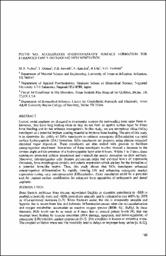
ATTENTION: The works hosted here are being migrated to a new repository that will consolidate resources, improve discoverability, and better show UTA's research impact on the global community. We will update authors as the migration progresses. Please see MavMatrix for more information.
Show simple item record
| dc.contributor.author | Velten, Megen F. | |
| dc.contributor.author | Odatsu, Tetsurou | |
| dc.contributor.author | Aswath, P. M. | |
| dc.contributor.author | Kamiya, N. | |
| dc.contributor.author | Kim, H. | |
| dc.contributor.author | Varanasi, Venu | |
| dc.date.accessioned | 2019-01-23T22:42:15Z | |
| dc.date.available | 2019-01-23T22:42:15Z | |
| dc.date.issued | 2014 | |
| dc.identifier.citation | Velten, M. F., Odatsu, T. , Aswath, P. , Kamiya, N. , Kim, H. and Varanasi, V. (2014). PECVD SiOx Accelerates Hydroxyapatite Surface Formation for Enhanced Early Osteogenic Differentiation. In Biomaterials Science: Processing, Properties and Applications IV (eds S. Bose, A. Bandyopadhyay and R. Narayan). https://doi.org/10.1002/9781118995235.ch11 | en_US |
| dc.identifier.other | 10.1002/9781118995235.ch11 | |
| dc.identifier.uri | http://hdl.handle.net/10106/27642 | |
| dc.description.abstract | **Please note that the full text is embargoed** ABSTRACT: Current metal implants are designed to structurally support the surrounding bone upon fracture. However, they have long healing times as they do not form an apatite surface layer for direct bone bonding and do not enhance osteogenesis. In this study, we use amorphous silica (SiOx) nanolayers as a potential implant coating material to improve bone healing. The aim of this study is to determine the ability of SiOx nanolayers to enhance osteogenic differentiation via rapid surface hydroxyapatite (HA) formation. SiOx nanolayers are prepared using plasma enhanced chemical vapor deposition. These nanolayers are also etched with grooves to facilitate osteoprogenitor attachment. Immersion of these nanolayers in-vitro showed a decrease in the contact angle and the presence of a hydroxyapatite layer after 6 hours. Within 1 to 3 days, these nanolayers promoted cellular attachment and extracellular matrix formation on their surfaces. Moreover, osteoprogenitor cells (human periosteum cells) had elevated levels of superoxide dismutase, bone morphogenic protein, and osterix expression which are key for the formation of a potential bone-like matrix. Thus, this study shows that SiOx nanolayers enhanced osteoprogenitor differentiation by rapidly forming HA and enhancing osteogenic marker expression during early osteoprogenitor differentiation. These nanolayers could be a potential tool for implant surface modification for enhanced bone apposition of orthopaedic and dental implants. | en_US |
| dc.language.iso | en_US | en_US |
| dc.publisher | Wiley | en_US |
| dc.relation.ispartofseries | Ceramic Transactions Series; | |
| dc.subject | Amorphous silica | en_US |
| dc.subject | Rapid surface hydroxyapatite | en_US |
| dc.subject | Osteoprogenitor cells | en_US |
| dc.subject | Morphogenic protein | en_US |
| dc.subject | Osterix expression | en_US |
| dc.title | PECVD SiOx Accelerates Hydroxyapatite Surface Formation for Enhanced Early Osteogenic Differentiation | en_US |
| dc.type | Book chapter | en_US |
Files in this item
- Name:
- Velten_et_al.pdf
- Size:
- 863.8Kb
- Format:
- PDF
This item appears in the following Collection(s)
Show simple item record


